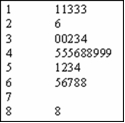 |
| 1 |  | 
For a stem-and-leaf display |
|  | A) | Arrange the leaf values from smallest to largest. |
|  | B) | Make sure the stem value is only one digit. |
|  | C) | Do not allow stems with no leaf values. |
|  | D) | Include decimal points. |
|
|
 |
| 2 |  | 
Questions 2 to 6 refer to the following information. It reports the number of TV sets sold per day at the Appliance SuperStore.  <a onClick="window.open('/olcweb/cgi/pluginpop.cgi?it=jpg::::/sites/dl/free/0073401765/663702/C4_img1.jpg','popWin', 'width=NaN,height=NaN,resizable,scrollbars');" href="#"><img valign="absmiddle" height="16" width="16" border="0" src="/olcweb/styles/shared/linkicons/image.gif"> (6.0K)</a> <a onClick="window.open('/olcweb/cgi/pluginpop.cgi?it=jpg::::/sites/dl/free/0073401765/663702/C4_img1.jpg','popWin', 'width=NaN,height=NaN,resizable,scrollbars');" href="#"><img valign="absmiddle" height="16" width="16" border="0" src="/olcweb/styles/shared/linkicons/image.gif"> (6.0K)</a>
The above arrangement is called a |
|  | A) | Frequency distribution |
|  | B) | A frequency polygon |
|  | C) | A pie chart |
|  | D) | A stem-and-leaf chart. |
|
|
 |
| 3 |  | 
 <a onClick="window.open('/olcweb/cgi/pluginpop.cgi?it=jpg::::/sites/dl/free/0073401765/663702/C4_img1.jpg','popWin', 'width=NaN,height=NaN,resizable,scrollbars');" href="#"><img valign="absmiddle" height="16" width="16" border="0" src="/olcweb/styles/shared/linkicons/image.gif"> (6.0K)</a> <a onClick="window.open('/olcweb/cgi/pluginpop.cgi?it=jpg::::/sites/dl/free/0073401765/663702/C4_img1.jpg','popWin', 'width=NaN,height=NaN,resizable,scrollbars');" href="#"><img valign="absmiddle" height="16" width="16" border="0" src="/olcweb/styles/shared/linkicons/image.gif"> (6.0K)</a>
How many days were studied? |
|  | A) | 11 |
|  | B) | 30 |
|  | C) | 50 |
|  | D) | None of the above |
|
|
 |
| 4 |  | 
 <a onClick="window.open('/olcweb/cgi/pluginpop.cgi?it=jpg::::/sites/dl/free/0073401765/663702/C4_img1.jpg','popWin', 'width=NaN,height=NaN,resizable,scrollbars');" href="#"><img valign="absmiddle" height="16" width="16" border="0" src="/olcweb/styles/shared/linkicons/image.gif"> (6.0K)</a> <a onClick="window.open('/olcweb/cgi/pluginpop.cgi?it=jpg::::/sites/dl/free/0073401765/663702/C4_img1.jpg','popWin', 'width=NaN,height=NaN,resizable,scrollbars');" href="#"><img valign="absmiddle" height="16" width="16" border="0" src="/olcweb/styles/shared/linkicons/image.gif"> (6.0K)</a>
What was the smallest and largest number of sets sold per day? |
|  | A) | 1, 8 |
|  | B) | 10, 80 |
|  | C) | 11, 88 |
|  | D) | None of the above |
|
|
 |
| 5 |  | 
 <a onClick="window.open('/olcweb/cgi/pluginpop.cgi?it=jpg::::/sites/dl/free/0073401765/663702/C4_img1.jpg','popWin', 'width=NaN,height=NaN,resizable,scrollbars');" href="#"><img valign="absmiddle" height="16" width="16" border="0" src="/olcweb/styles/shared/linkicons/image.gif"> (6.0K)</a> <a onClick="window.open('/olcweb/cgi/pluginpop.cgi?it=jpg::::/sites/dl/free/0073401765/663702/C4_img1.jpg','popWin', 'width=NaN,height=NaN,resizable,scrollbars');" href="#"><img valign="absmiddle" height="16" width="16" border="0" src="/olcweb/styles/shared/linkicons/image.gif"> (6.0K)</a>
How many days were there less than 30 sets sold? |
|  | A) | 15 |
|  | B) | 6 |
|  | C) | 30 |
|  | D) | None of the above |
|
|
 |
| 6 |  | 
 <a onClick="window.open('/olcweb/cgi/pluginpop.cgi?it=jpg::::/sites/dl/free/0073401765/663702/C4_img1.jpg','popWin', 'width=NaN,height=NaN,resizable,scrollbars');" href="#"><img valign="absmiddle" height="16" width="16" border="0" src="/olcweb/styles/shared/linkicons/image.gif"> (6.0K)</a> <a onClick="window.open('/olcweb/cgi/pluginpop.cgi?it=jpg::::/sites/dl/free/0073401765/663702/C4_img1.jpg','popWin', 'width=NaN,height=NaN,resizable,scrollbars');" href="#"><img valign="absmiddle" height="16" width="16" border="0" src="/olcweb/styles/shared/linkicons/image.gif"> (6.0K)</a>
The actual number of sets sold per day between 60 and 69 is |
|  | A) | 65, 66, 67, 68, 68 |
|  | B) | 60, 69 |
|  | C) | Cannot tell from the information given |
|  | D) | None of the above |
|
|
 |
| 7 |  | 
To draw a box plot that summarizes a data set, |
|  | A) | Two values are required: 1st quartile, 3rd quartile, |
|  | B) | Three values are required: minimum, median, and maximum |
|  | C) | Four values are required: minimum, 1st quartile, 3rd quartile, and maximum |
|  | D) | Five values are required: minimum, 1st quartile, median, 3rd quartile, and maximum |
|
|
 |
| 8 |  | 
The inter quartile range of a set of observations is |
|  | A) | The difference between the minimum and maximum values |
|  | B) | The standard deviation. |
|  | C) | The difference between the 1st and 3rd quartiles. |
|  | D) | Appropriate only for symmetric distributions. |
|
|
 |
| 9 |  | 
For any symmetric distribution |
|  | A) | The mean, median, and mode are equal. |
|  | B) | The mean is the largest measure of location. |
|  | C) | The median is the largest measure of location. |
|  | D) | The standard deviation is the largest value. |
|
|
 |
| 10 |  | 
A coefficient of skewness of -2.73 was computed for a set of data. We conclude that |
|  | A) | The mean is larger than the median. |
|  | B) | The median is larger than the mean. |
|  | C) | The standard deviation is a negative number. |
|  | D) | Something is wrong because the coefficient of skewness cannot be less than -1.00. |
|
|
 |
| 11 |  | 
The purpose of a contingency table is to summarize |
|  | A) | Two continuous, ratio variables |
|  | B) | Two discrete, ratio variables |
|  | C) | Two discrete, nominal or ordinal variables. |
|  | D) | Two discrete, continuous variables. |
|
|
 |
| 12 |  | 
A scatter diagram: |
|  | A) | Is a graphic tool designed to portray the relationship between variables. |
|  | B) | Uses interval or ratio scale data. |
|  | C) | Does not allow negative values. |
|  | D) | Both A and B are correct. |
|
|

